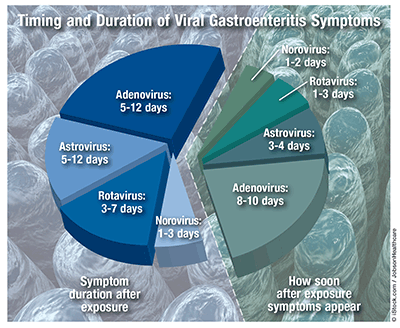US Pharm. 2015;40(12):7.
According to the CDC, there were 4.6 million hospitalizations, 72 million ambulatory care visits, and 236,000 deaths related to gastrointestinal (GI) diseases in the United States in 2004, and 68.6% of patients got sick because of foodborne pathogens. Most people recover from gastroenteritis without any complications. The four most common types of viral gastroenteritis (VGE), which is highly contagious, are rotavirus, norovirus, adenovirus, and astrovirus.

Rotavirus: Rotavirus is the leading cause of severe acute VGE among infants (age 3-15 months) and young children. Three million cases of rotavirus disease occur each year, and 95% of children are infected by age 5 years. Annually, rotavirus disease contributes to 400,000 physician visits, 200,000 emergency department (ED) visits, 55,000 to 70,000 hospitalizations, and 20 to 60 deaths. Two FDA-approved vaccines are 85% to 98% protective against severe rotavirus disease and 74% to 87% are protective against all degrees of severity, but there are adverse reactions. These vaccines have dramatically decreased hospitalizations and ED visits.
Norovirus: Norovirus, the leading cause of illness and outbreaks from contaminated food, is the most common cause of VGE in people of all ages. This infection occurs mostly from October to April. Each year, norovirus is responsible for 19 to 21 million cases of acute VGE, 1.7 to 1.9 million (1 in 2) outpatient visits, 56,000 to 71,000 (1 in 50-70) hospitalizations, and 570 to 800 (1 in 5,000-7,000) deaths, primarily in young children and older adults. Norovirus is responsible for 16% of all acute VGE in the community and for 12% of cases treated in outpatient settings. Annually, norovirus is responsible for nearly 1 million pediatric care visits. By age 5 years, 1 in 278 children will be hospitalized, 1 in 14 will visit an ED, and 1 in 6 will receive outpatient care for norovirus.
Adenovirus: Of the 49 strains of adenoviruses, one strain affects the GI system. Adenovirus is active year-round and mainly infects children younger than 2 years.
Astrovirus: Astrovirus, the fourth most common cause of VGE, occurs most frequently in children younger than 2 years, with rarer outbreaks in adults and the elderly population. In studies, 12% of patients did not exhibit GI symptoms; however, 90% of children have antibody by 9 years of age, indicating that astrovirus is a largely asymptomatic infection. Although astrovirus occurs year-round, it is most active during the winter months. Symptoms are milder than those of norovirus or rotavirus. Astrovirus is associated with 5% to 9% of VGE cases in young children.
To comment on this article, contact rdavidson@uspharmacist.com.





